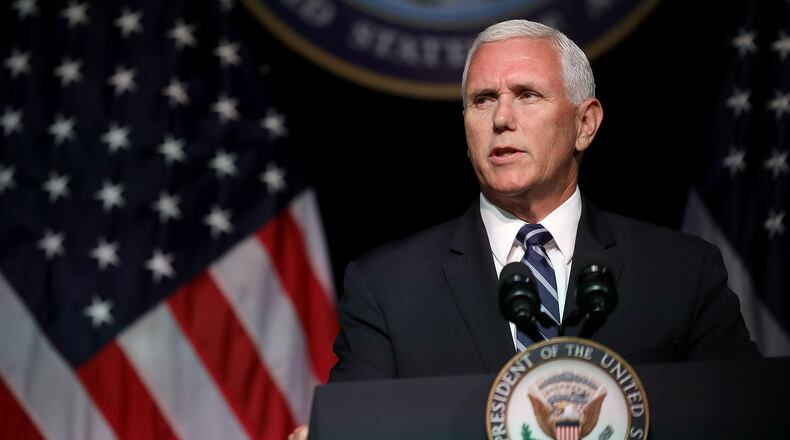» RELATED: Wright-Patt hospital leader: Teamwork ‘saved lives’ during shooter scare
“Most of the Air Force space development work is conducted away from Wright-Patt,” Thompson said. “But, this does raise the question of what happens to NASIC. I think for the time being nothing changes because we need to to keep our air and space intelligence integrated.”
With more than 27,000 employees, Wright-Patt is the largest single-site employer in Ohio with an annual economic impact of around $4 billion.
A Pentagon report released Thursday said the new “U.S. Space Command” would be responsible for drafting war plans for space and for conducting military operations in space, much like Central Command draws from all military services and is responsible for fighting wars in the Middle East.
The Air Force has a nearly $8.5-billion budget for launching satellites and other space systems and military officials have expressed concern over what the creation of a space force would mean for that funding.
The agency also would take over space contracting that now spread across other services and agencies. The Trump administration is requesting $12.5 billion for unclassified military space programs next year. Most of the money — $11.4 billion — would go to the Air Force, along with an unknown amount in classified spending.
NASIC employs more than 3,000 military, civilian, reserve, guard and contract personnel and the agency is planning a $182-million expansion of its facilities at Wright-Patt. The intelligence agency analyzes air, space, and cyber threats, such as ballistic missile capabilities, and provides findings to the nation’s political and military leaders.
A space force would probably have 30,000 to 40,000 personnel, drawn mostly from the Air Force but also from the Army and possibly the National Reconnaissance Office, the little-known intelligence agency responsible for building and launching spy satellites.
» RELATED: Wright-Patt to get $182M for NASIC expansion: 5 things to know
That would make the space force by far the smallest military service, behind the Marine Corps, which has an active duty force of 186,100 this year. The Marine Corps is part of the U.S. Navy and creating a Space Corps as part of the Air Force would be a better idea than creating a separate service so that space intelligence and analysis wouldn’t be further splintered among the armed forces, Thompson said.
Sen. Sherrod Brown has discussed military efforts in meetings with Air Force Secretary Heather Wilson, according to his office. Brown has expressed concern that creating a new space-focused branch would pull resources from the current branches of the military.
The Outer Space Treaty, which the United States signed in 1967, bars states from testing weapons and establishing military bases on the moon and other celestial bodies. It also prohibits the placement of weapons of mass destruction in orbit around Earth. But the treaty has no enforcement mechanism (indeed, the Air Force’s unmanned space plane, the X-37B, has completed several clandestine missions).
Complicating matters even more, the Air Force has its own lower-level Space Command. Headquartered at Peterson Air Force Base in Colorado, it oversees the Space and Missile Systems Center in El Segundo, as well missile launch operations at Vandenberg Air Force Base and other Air Force space units.
Before a space force is considered, leaders must first figure out how it will impact service members, including those at Wright-Patt, Brown said.
“Of course we must be able to counter our adversaries in space – that’s why the Air Force Space Command and other similar programs and agencies are already working to ensure we have the capabilities to address such threats. Our first priority should be supporting their mission and ensuring they have the resources they need,” Brown said in a prepared statement.
» RELATED: Fake veterans charity collected millions in donations from Ohioans
President Donald Trump started calling for the creation of a space-focused military branch months ago and he has not let the issue go. At a campaign rally Saturday for a congressional candidate near Columbus, Trump said he had “directed the Pentagon to begin the process of creating the sixth branch of the United States Armed Forces called the space force. Space, very important.”
Even with Trump’s continued support and Pence’s renewed call for a space force on Thursday, the proposal faces an uncertain future.
A space force would need congressional approval and many leaders at the Pentagon and in the U.S. House and Senate have voiced opposition and skepticism to the idea.
“Nobody in the Pentagon likes this idea and I think there’s a suspicion in the building that the people who came up with it don’t understand the complexities,” Thompson said.
U.S. Rep. Mike Turner, R-Dayton, has been an advocate of top Air Force leaders retaining the space mission. A congressionally mandated report evaluating a Space Force is due in August, he has said.
Congress still doesn’t know exactly what a space force would do or how much it would cost, Turner has said.
“After we get the report that we required as a legislative body and the President signed off on, then this issue can be appropriately evaluated for what’s best for national security,” said Turner, chairman of the Tactical Air and Land Forces subcommittee.
FIVE FAST READS
• New furniture store to open location at two Dayton-area malls
• Wright State president not given raise, bonus due to budget issues
• Good Samaritan Hospital officially closes down for good
• State suing Dayton company for ‘shoddy work
• Algae plaguing Ohio lakes could force Kasich to take executive action
THANKS FOR READING
The Dayton Daily News is committed to bringing you independent, in-depth local stories. Help support our journalism by signing up for a print or digital subscription.
